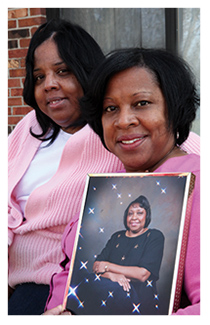A Family’s Story: Mother and Daughters Witness Advances In Cancer Care
 When they were out together, it was easy to see that Beulah Stephens and daughters Penny and Robbin were family. People often mistook the girls – nine
months apart in age – for twins. But as years passed, a more troubling relationship arose.
All three were diagnosed with
breast cancer. Separated by decades, the experiences of Beulah, Penny (now Myers), and Robbin (now Jones) chart great strides in treatment and hope.
When they were out together, it was easy to see that Beulah Stephens and daughters Penny and Robbin were family. People often mistook the girls – nine
months apart in age – for twins. But as years passed, a more troubling relationship arose.
All three were diagnosed with
breast cancer. Separated by decades, the experiences of Beulah, Penny (now Myers), and Robbin (now Jones) chart great strides in treatment and hope.
The 1970s
Breast cancer struck Beulah in her early 30s. Rarely done today, the treatment of choice then was a radical mastectomy.
A surgeon removed the breast, underlying chest muscle, and nearby lymph nodes. Chemotherapy and radiation followed. She survived the cancer, although Robbin recalls that her mother had heart muscle damage from the radiation.
Still, Beulah was a strong woman. Her four children didn’t see what she was going through. “She didn’t share that,” Robbin says.
The 1990s
Both girls had been having regular annual mammogram when Robbin’s breast cancer surfaced in her early 30s. It was 1996. “I looked at mom, thinking, ‘I’ll make it through.’” Robbin had a breast-sparing lumpectomy with chemo after radiation.
She was overwhelmed with printed material about the disease. “You had to read it all to try to understand what was going on with you,” Robbin says.
Beulah was her entire support group. “I let her guide me in prayer and trust in the Lord,” Robbin says. To be strong for her own daughter, Robbin didn’t deal with the emotional and physical changes. Those hit her hard a few years after she finished treatment.
2011
Penny was used to being called back for re-screenings after her annual mammogram, so the call from the Breast Center in late 2011 didn’t worry her. “This time they saw two small spots on my right breast,” she says.
The breast care team quickly went to work. At the center, a doctor inserted a thin needle to remove a tiny sample of breast tissue for study under a microscope. The test revealed the presence of cancer cells.
Breast Care Coordinator Ann Lensch, RN, accompanied Penny to her first meeting with a surgeon. Together, they weighed Penny’s options. She chose a lumpectomy. During the procedure, Penny’s surgeon biopsied the other suspicious spot. Fortunately, the biopsy found no cancer.
Lensch visited Penny the day of her surgery and brought her “A Woman’s Journey Toward Healing,” a guidebook for all aspects of breast cancer. “She called a couple days later to check on me, too,” Penny remembers.
Next, the medical oncologist who would coordinate Penny’s post-surgery care sent tissue samples from Penny’s surgery for laboratory analysis. The results would help define which treatment would most benefit her. The answer was hormone manipulation, enabling Penny to avoid the chemotherapy Robbin had. “They don’t put you through unnecessary treatment,” she says.
Penny completed radiation treatments at Miami Valley Hospital North and then started hormone therapy with tamoxifen.
Science Enables Personalized Treatment
Since Beulah’s cancer treatment, great strides have been made in improving cancer care. More is understood about the role of hormones in breast cancer, the drugs that reduce the chance of cancer returning, and genes that signal increased cancer risk.
This new knowledge enables doctors to personalize treatment and improve outcomes.
Digital mammography and needle biopsies have made detection less traumatic and invasive. “One of our greatest advances is identifying risk,” says surgeon Thomas Heck, MD of Gem City Surgeons. “We started our High Risk Program to identify women with a positive BRCA gene test indicating a very high risk of developing breast and ovarian cancer.”
On the long survivorship road, cancer patients today don’t have to journey alone. “Support groups are out there in full force,” Robbin says. “There’s someone going through the same things you are. They help you know you can survive.”
Improvements In Breast Cancer Care: A World Of Difference
Surgery
Surgeons can identify and remove only lymph nodes that need to be removed, reducing the risk of swollen arms. New reconstruction techniques offer improved cosmetic results.
Radiation
Improved radiation delivery does less damage to healthy tissue. For some patients, treatment can be tightly targeted through a balloon inserted into the lumpectomy cavity. Another benefit: treatment takes only five days, not six weeks.
Chemotherapy
Drugs are more effective in fighting cancer and in helping patients tolerate treatment. The aim is to provide patients greater benefit with minimal side effects.
Genetic Counseling
Today’s sophisticated testing can rule out many genetic concerns. Women who received genetic counseling years ago should return for a reevaluation.

Contact Us
Call the Premier Health cancer hotline at (844) 316-HOPE(844) 316-4673 (4673), Monday through Friday, 8 a.m. to 5 p.m., for more information.

